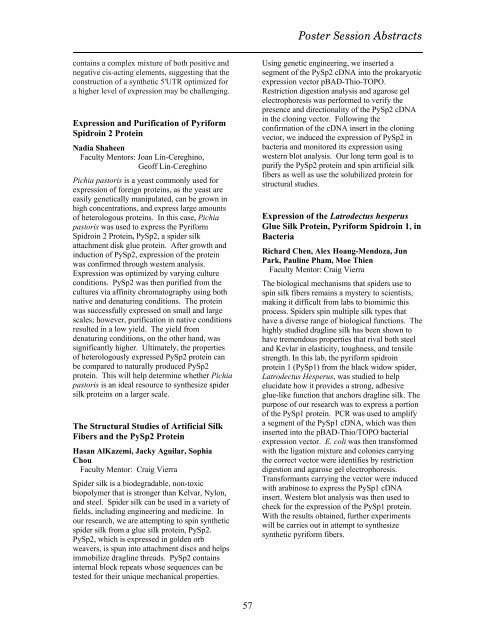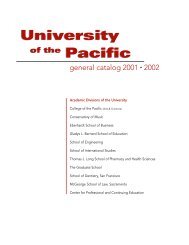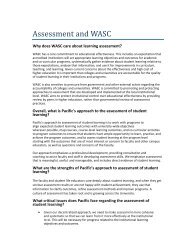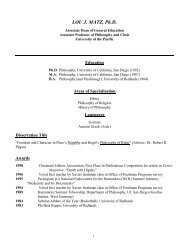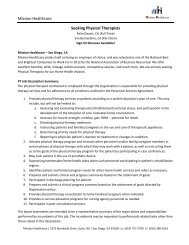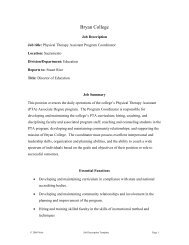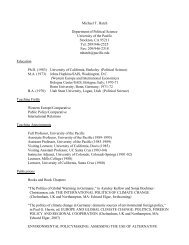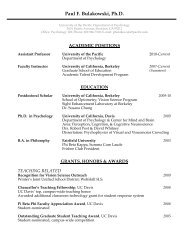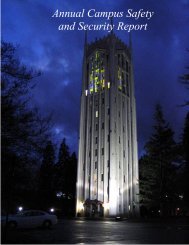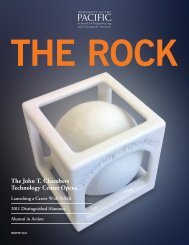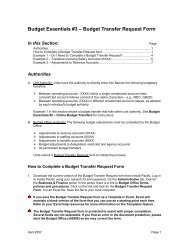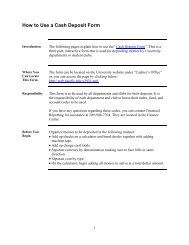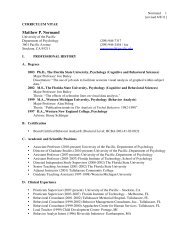purcc 2012 - University of the Pacific
purcc 2012 - University of the Pacific
purcc 2012 - University of the Pacific
Create successful ePaper yourself
Turn your PDF publications into a flip-book with our unique Google optimized e-Paper software.
Poster Session Abstracts<br />
contains a complex mixture <strong>of</strong> both positive and<br />
negative cis-acting elements, suggesting that <strong>the</strong><br />
construction <strong>of</strong> a syn<strong>the</strong>tic 5'UTR optimized for<br />
a higher level <strong>of</strong> expression may be challenging.<br />
Expression and Purification <strong>of</strong> Pyriform<br />
Spidroin 2 Protein<br />
Nadia Shaheen<br />
Faculty Mentors: Joan Lin-Cereghino,<br />
Ge<strong>of</strong>f Lin-Cereghino<br />
Pichia pastoris is a yeast commonly used for<br />
expression <strong>of</strong> foreign proteins, as <strong>the</strong> yeast are<br />
easily genetically manipulated, can be grown in<br />
high concentrations, and express large amounts<br />
<strong>of</strong> heterologous proteins. In this case, Pichia<br />
pastoris was used to express <strong>the</strong> Pyriform<br />
Spidroin 2 Protein, PySp2, a spider silk<br />
attachment disk glue protein. After growth and<br />
induction <strong>of</strong> PySp2, expression <strong>of</strong> <strong>the</strong> protein<br />
was confirmed through western analysis.<br />
Expression was optimized by varying culture<br />
conditions. PySp2 was <strong>the</strong>n purified from <strong>the</strong><br />
cultures via affinity chromatography using both<br />
native and denaturing conditions. The protein<br />
was successfully expressed on small and large<br />
scales; however, purification in native conditions<br />
resulted in a low yield. The yield from<br />
denaturing conditions, on <strong>the</strong> o<strong>the</strong>r hand, was<br />
significantly higher. Ultimately, <strong>the</strong> properties<br />
<strong>of</strong> heterologously expressed PySp2 protein can<br />
be compared to naturally produced PySp2<br />
protein. This will help determine whe<strong>the</strong>r Pichia<br />
pastoris is an ideal resource to syn<strong>the</strong>size spider<br />
silk proteins on a larger scale.<br />
The Structural Studies <strong>of</strong> Artificial Silk<br />
Fibers and <strong>the</strong> PySp2 Protein<br />
Hasan AlKazemi, Jacky Aguilar, Sophia<br />
Chou<br />
Faculty Mentor: Craig Vierra<br />
Spider silk is a biodegradable, non-toxic<br />
biopolymer that is stronger than Kelvar, Nylon,<br />
and steel. Spider silk can be used in a variety <strong>of</strong><br />
fields, including engineering and medicine. In<br />
our research, we are attempting to spin syn<strong>the</strong>tic<br />
spider silk from a glue silk protein, PySp2.<br />
PySp2, which is expressed in golden orb<br />
weavers, is spun into attachment discs and helps<br />
immobilize dragline threads. PySp2 contains<br />
internal block repeats whose sequences can be<br />
tested for <strong>the</strong>ir unique mechanical properties.<br />
Using genetic engineering, we inserted a<br />
segment <strong>of</strong> <strong>the</strong> PySp2 cDNA into <strong>the</strong> prokaryotic<br />
expression vector pBAD-Thio-TOPO.<br />
Restriction digestion analysis and agarose gel<br />
electrophoresis was performed to verify <strong>the</strong><br />
presence and directionality <strong>of</strong> <strong>the</strong> PySp2 cDNA<br />
in <strong>the</strong> cloning vector. Following <strong>the</strong><br />
confirmation <strong>of</strong> <strong>the</strong> cDNA insert in <strong>the</strong> cloning<br />
vector, we induced <strong>the</strong> expression <strong>of</strong> PySp2 in<br />
bacteria and monitored its expression using<br />
western blot analysis. Our long term goal is to<br />
purify <strong>the</strong> PySp2 protein and spin artificial silk<br />
fibers as well as use <strong>the</strong> solubilized protein for<br />
structural studies.<br />
Expression <strong>of</strong> <strong>the</strong> Latrodectus hesperus<br />
Glue Silk Protein, Pyriform Spidroin 1, in<br />
Bacteria<br />
Richard Chen, Alex Hoang-Mendoza, Jun<br />
Park, Pauline Pham, Moe Thien<br />
Faculty Mentor: Craig Vierra<br />
The biological mechanisms that spiders use to<br />
spin silk fibers remains a mystery to scientists,<br />
making it difficult from labs to biomimic this<br />
process. Spiders spin multiple silk types that<br />
have a diverse range <strong>of</strong> biological functions. The<br />
highly studied dragline silk has been shown to<br />
have tremendous properties that rival both steel<br />
and Kevlar in elasticity, toughness, and tensile<br />
strength. In this lab, <strong>the</strong> pyriform spidroin<br />
protein 1 (PySp1) from <strong>the</strong> black widow spider,<br />
Latrodectus Hesperus, was studied to help<br />
elucidate how it provides a strong, adhesive<br />
glue-like function that anchors dragline silk. The<br />
purpose <strong>of</strong> our research was to express a portion<br />
<strong>of</strong> <strong>the</strong> PySp1 protein. PCR was used to amplify<br />
a segment <strong>of</strong> <strong>the</strong> PySp1 cDNA, which was <strong>the</strong>n<br />
inserted into <strong>the</strong> pBAD-Thio/TOPO bacterial<br />
expression vector. E. coli was <strong>the</strong>n transformed<br />
with <strong>the</strong> ligation mixture and colonies carrying<br />
<strong>the</strong> correct vector were identifies by restriction<br />
digestion and agarose gel electrophoresis.<br />
Transformants carrying <strong>the</strong> vector were induced<br />
with arabinose to express <strong>the</strong> PySp1 cDNA<br />
insert. Western blot analysis was <strong>the</strong>n used to<br />
check for <strong>the</strong> expression <strong>of</strong> <strong>the</strong> PySp1 protein.<br />
With <strong>the</strong> results obtained, fur<strong>the</strong>r experiments<br />
will be carries out in attempt to syn<strong>the</strong>size<br />
syn<strong>the</strong>tic pyriform fibers.<br />
57


